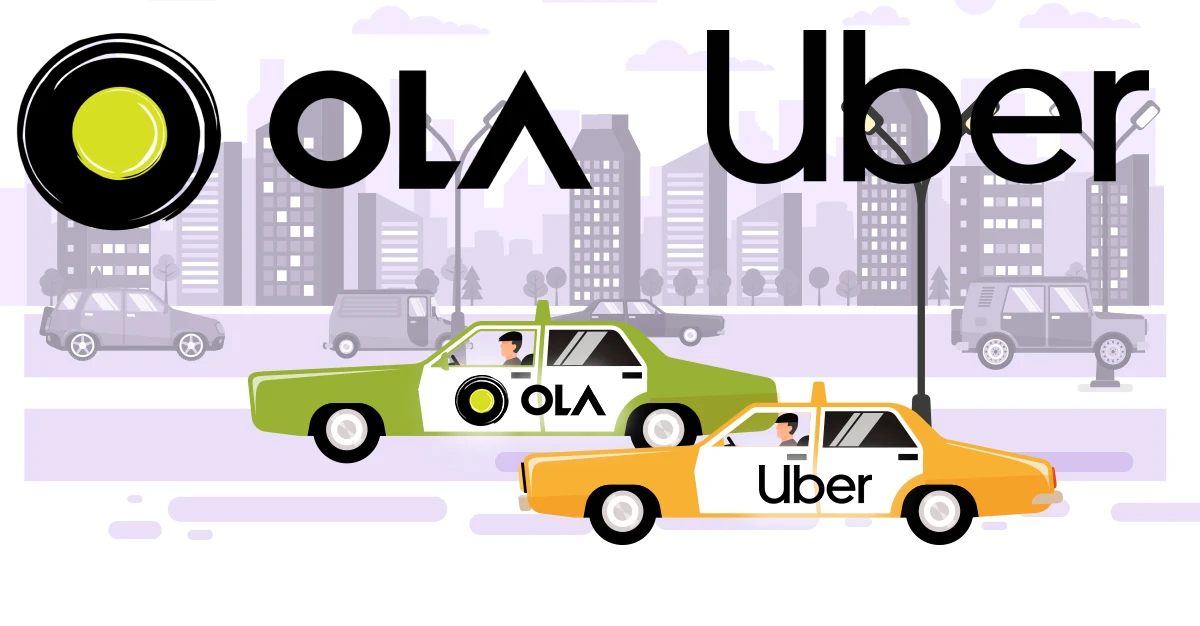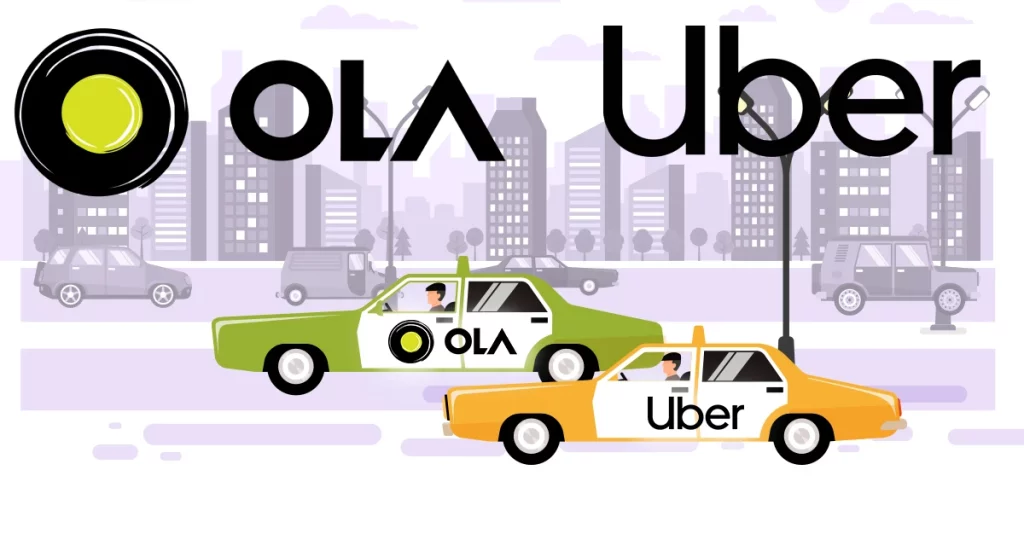Emerged in the 17th century, taxis/cabs have become an integral part of the global public transport chain including India. Do you know what the Indian taxi market size is? It is over 1.9 million. The arrival of on-demand and online car rentals has organized the market to a greater extent. Can you guess who the ruling player in the segment is? Well, it is not one but two! Ola & Uber. As a result, the most heated topic today is Ola vs Uber. But which one is doing better business in India? You will find out in this article.

Stay tuned!
Rise of online cabs with digitalization
With the rise of the internet and digitalization, various services are available at your doorstep. Be it food from a restaurant, groceries, apparel, or taxi. Don’t you look for ways to save time and effort while traveling? Although cost-effective public transport is available too. But we all know the hassle that Indians go through while traveling in a public auto or bus.
What if you are given a choice of a personalized car ride at nearly the same cost as public transport? You would definitely prefer a cab ride over a public bus. Reason? Comfortable ride at an affordable price! That’s the reason cab-hailing services are at the center of the public’s attention. And when it comes to online cab booking services, the two names that hover in your mind are- Ola and Uber. But how would you determine which one is doing better business in India? We have described it in the next section.
A Brief Overview of Ola and Uber
Ola and Uber are popular ride-hailing platforms that operate globally, providing convenient transportation services through mobile applications. Both companies connect passengers with drivers using their respective platforms, allowing users to book rides easily and track their driver’s arrival.
Ola
Headquartered in Bengaluru (Karnataka), Ola is an Indian-based company that launched in 2010. It offers a range of transportation options, including auto-rickshaws, taxis, and more recently, electric vehicles. Ola operates in several countries, including India, Australia, New Zealand, and the United Kingdom. Some other services of Ola are-
- Ola Fleet: It involves the leasing of taxis to partnered drivers
- Ola Foods: Do you know, Ola acquired the Indian subsidiary of Foodpanda in 2017? With this, Ola entered into the food delivery segment. Thus, it competed with Zomato & Swiggy.
- Ola Financial Services: In 2015, Ola launched mobile payments and wallet services in the Ola app. It was called OlaMoney. It offered lucrative financial services like buy now pay later, insurance, vehicle loans, and credit cards.
- Ola Electric: Ola Electric Mobility is an Indian electric two-wheeler manufacturer, based in Bengaluru. It was established in 2017 as a wholly-owned subsidiary of ANI Technologies, the parent entity of Ola Cabs.
- Ola Ambulance: Ola has been providing Ola Emergency medical care services in several cities throughout India since Covid-19. It enables citizens to access essential medical care without any delay. (However, there are no latest updates on Ola Emergency Services. In case we find any authentic and latest reports, we will update you soon!)
Uber
Headquartered in the US, Uber was founded in 2009. It is one of the pioneers of the ride-hailing industry. It operates in numerous countries and cities worldwide, offering various types of rides, such as economy, premium, and shared options. Some other services of Uber are-
- Uber Eats: It is a network of local restaurants and food delivery services.
- Uber for Business: A ride-sharing service targeting business customers. Here, you can book the rides in advance for your clients or employees.
- Uber Health: It partnered with healthcare organizations to provide healthcare services similar to PharmEasy and Tata 1mg.
Let’s briefly look at Uber’s financials. In FY23, Uber Inc. earned $19 billion from its ride-hailing vertical. However, India contributed less than 1% to Uber’s overall global revenues.
Here’s how-
| Uber India Revenue Share | 2022 | 2023 |
| Uber’s global ride revenue | Rs.1,12,000 crore | Rs.1,52,000 crore |
| India’s share in global revenue | 388 | 678 |
| % of India’s Operating Revenue in Uber’s Global Revenue | 0.3% | 0.4% |
Not just that, Uber’s average order value (AOV) in India is much lower as compared to other developed countries like Australia whose AOV is $30 per ride.
Here’s a brief comparison-
| Uber’s AOV in India & World | 2022 | 2023 |
| No. of rides in the year | $7,642 million | $9,448 million |
| Gross bookings for the year | 1,12,395 | 1,37,865 |
| Global AOV | $15.1 | $14.6 |
| India AOV | $4.1 (Rs.300-350) | $4.1 (Rs.300-350) |
Both Ola and Uber utilize GPS technology to match passengers with nearby drivers, ensuring efficient and convenient service. The applications provide estimated arrival times, fare estimates, and cashless payment options, enhancing the overall user experience.
These platforms have faced regulatory challenges and competition in some markets, but they have revolutionized the way people access transportation services by providing an alternative to traditional taxis. Ola and Uber have greatly influenced the transportation industry and continue to evolve, introducing innovative features and expanding their services globally.
Ola vs Uber
You need to consider the following factors to determine who is doing better business in India. Ola or Uber?
Factors to Consider
Look at the points below-
- Revenue & Profitability: A higher revenue and consistent profitability indicate successful business operations.
- Market Share: Increasing market share suggests that the company is gaining traction and outperforming competitors.
- Customer Base: A growing customer base and positive feedback indicate that the company is meeting customer needs effectively.
- Product or Service Demand: Strong demand indicates that the company’s offerings resonate with the target audience.
- Expansion & Growth: Expanding operations signifies confidence in the Indian market and potential growth opportunities.
- Regulatory Compliance: Adhering to the legal requirements (laws, regulations, and licenses) of the country demonstrates good governance and minimizes risks.
- Partnerships & Alliances: Collaborations and alliances with local businesses or organizations can provide access to new markets, resources, and expertise.
- Workforce: A strong and dedicated workforce is crucial for sustained business success.
- Brand Reputation: A positive brand image enhances customers’ trust and loyalty. Despite some controversies, both Ola and Uber are reputed brands.
A Quick Comparison
Now, let’s compare both companies i.e. Ola vs Uber to determine who is doing better business in our country.
| Particulars | Ola | Uber |
| Market Valuation/ Market Capitalization | $1.88 billion (Market Valuation in FY24) | $12.948 trillion (Global Market Capitalization) |
| Revenue (Consolidated Revenue in India) | Rs.2,799 (FY23) Rs.983.2 crore (FY22) | Rs.2,666 (FY23) Rs.397 crore (FY22) |
| Profit/Loss | Profit of Rs.250 crore (FY23) Loss of Rs.66 crore (FY22) | Loss of Rs.311 crore (FY23) Loss of Rs.216 crore (FY22) |
| Market Share (By Ride Volume in States) | Ladakh, J&K, Himachal Pradesh, Uttarakhand, Madhya Pradesh, Bihar, Jharkhand, Chattisgarh, Odisha, Andhra Pradesh, Arunachal Pradesh, Nagaland, Tripura | Punjab, Haryana, Rajasthan, Maharashtra, Karnataka, Telangana, Kerala, West Bengal, Assam |
| Customer Base | 125 million users (India) | 131 million users (Global) |
| Partnership & Alliances | Banks & Financial Institutions (HDFC Bank, ICICI Bank, Kotak Mahindra Bank), Ayushman Bharat (Healthcare Benefits), | Tata Motors Passenger Vehicles, Tata Passenger Electric Mobility, Oracle (Cloud Partnership). Google Cloud |
| Workforce | 20,895 employees (Global) | 88,899 employees (Global) |
| Services | Ola ride, Ola money, In-cab promotions and advertisements, Ola Play | Uber Ride, Uber Eats, Uber for Business, Uber Health |
| Bookings per day | 3 million | 18.7 million (Global) |
Before reaching any conclusion, you must look at the other key differences too. Those are described in the next section.
Comparison of Services
Although most of their services are the same, they still have some notable differences. Those are described below-
| Comparison Criteria | Ola | Uber |
| Car Types | Sedans, SUVs, Luxury Sedans | Sedans, SUVs, Accessible Vehicles, Premium Cars |
| Review & Feedback Submission | Only available for riders | Available for both rider and driver |
| Advance booking facility | Only available in the Ola app not on the web application | Available |
| Affordability | Costlier | Cheaper |
| Criticism | Lack of transparency in charging and refunding, Driver’s credibility, assaults on Ola cab drivers, and dropping driver incentives, inhospitable drivers (Cancelling customer’s requests without giving proper reasons). | Not binding with the local regulations, Sexual harassment allegations, Data breaches, inhospitable drivers (Cancelling customer’s requests without giving proper reasons), etc. |
So, now it is the time to decide who the winner is in the battle of Ola vs Uber!
Final Words: Who is the winner?
As you can see, Ola and Uber are in cutthroat competition with each other. Although from the data given in the above table, you may feel that Uber is more successful than Ola in terms of users, and bookings per day. But did you note the point that Uber is a global brand headquartered in San Francisco (California, US)? Whereas Ola is a domestic brand. That’s why it is far behind Uber in some particulars. Even though Ola also operates in many countries, the majority of its users are Indians. From a broad point of view, the ultimate benchmark to determine the quality of business is its profits!
No matter how much you are investing in your business, if it doesn’t generate profits even after a decade of its establishment. Then it becomes a matter of concern. In Uber, both driver and rider can share their reviews. This makes it more trustworthy for the drivers. Also, Uber is far much cheaper than Ola. This makes the former more popular than the latter. So as of now, we can say that Uber is doing better business in India!


In my view Uber is doing the best business.Uber has come out as a safer riding choice compared to Ola. On a scale of 1-10, customers scored Uber at a stellar 9, while Ola had to settle for an abysmal 3.6, depicting a huge disparity between the two cab aggregators.
Also, Delhi NCR people prefer Uber over Ola due to low fares when compared. Uber has expanded it’s verticals as in Uber eats, Uber Health & Uber for Business which shows it caters the need of the generation by giving best experience.